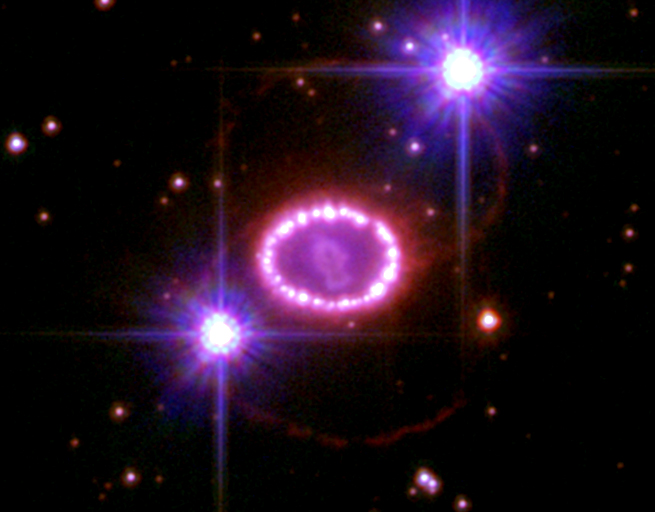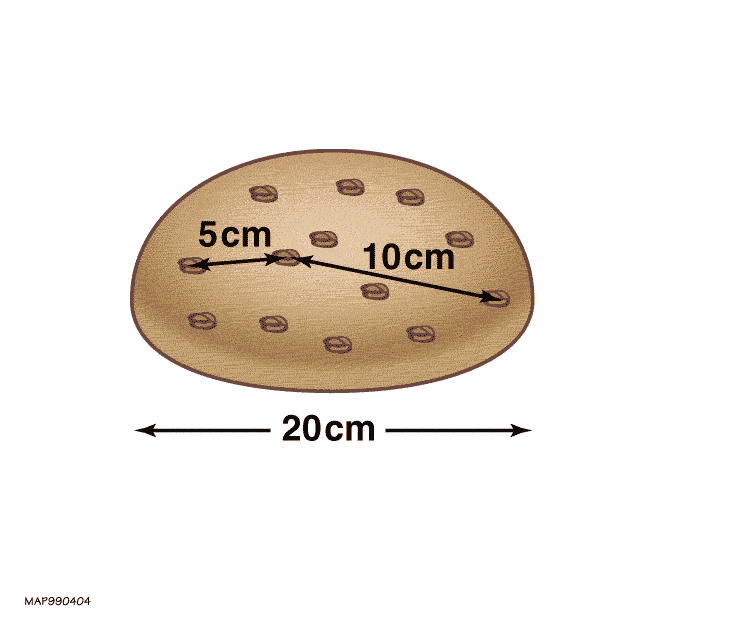|
Expanding Photosphere Method
The expanding photosphere method (EPM) is a method used to measure distances to Type II supernovae. It was developed by Robert Kirshner and John Kwan in 1974, based on the Baade–Wesselink method (1926). EPM is a geometrical method that compares a supernova's angular size to its physical size determined from spectroscopic measurements. The method works by comparing a supernova photosphere's angular radius ''θ'' to its linear radius ''R'' to calculate its distance ''d'' through direct geometric calculation. This calculation requires determining two key parameters: the temperature of the ejecta's photosphere and its expansion velocity. The temperature is typically found by fitting a blackbody curve to the continuum spectrum. The photosphere's expansion velocity is calculated from the Doppler blueshift of specific absorption lines that form at the photosphere. Isolated, easily identified spectral lines should be used for calculations, because blended or misidentified lines can i ... [...More Info...] [...Related Items...] OR: [Wikipedia] [Google] [Baidu] |
Type II Supernova
A Type II supernova or SNII (plural: ''supernovae'') results from the rapid collapse and violent explosion of a massive star. A star must have at least eight times, but no more than 40 to 50 times, the mass of the Sun () to undergo this type of explosion. Type II supernovae are distinguished from other types of supernovae by the presence of hydrogen in their spectra. They are usually observed in the spiral arms of galaxies and in H II regions, but not in elliptical galaxies; those are generally composed of older, low-mass stars, with few of the young, very massive stars necessary to cause a supernova. Stars generate energy by the nuclear fusion of elements. Unlike the Sun, massive stars possess the mass needed to fuse elements that have an atomic mass greater than hydrogen and helium, albeit at increasingly higher temperatures and pressures, causing correspondingly shorter stellar life spans. The degeneracy pressure of electrons and the energy generated by th ... [...More Info...] [...Related Items...] OR: [Wikipedia] [Google] [Baidu] |
Robert Kirshner
Robert P. Kirshner (born August 15, 1949) is an American astronomer, Chief Program Officer for Science for the Gordon and Betty Moore Foundation, and the Clowes Research Professor of Science at Harvard University. Kirshner has worked in several areas of astronomy including the physics of supernovae, supernova remnants, the large-scale structure of the cosmos, and the use of supernovae to measure the expansion of the universe. Career Kirshner received his A.B. ''magna cum laude'' in Astronomy from Harvard College in 1970, where he also won a Bowdoin Prize for Useful and Polite Literature. He earned his Ph.D., also in Astronomy, from Caltech in 1975. He then worked as a postdoc at the Kitt Peak National Observatory, before joining the faculty at the University of Michigan, where he rose to become Professor and Chairman of the Astronomy Department and helped to build the 2.4 meter Hiltner Telescope. Whilst at Michigan, he received an Alfred P. Sloan Fellowship and won the Henry R ... [...More Info...] [...Related Items...] OR: [Wikipedia] [Google] [Baidu] |
John Kwan
John is a common English name and surname: * John (given name) * John (surname) John may also refer to: New Testament Works * Gospel of John, a title often shortened to John * First Epistle of John, often shortened to 1 John * Second Epistle of John, often shortened to 2 John * Third Epistle of John, often shortened to 3 John People * John the Baptist (died ), regarded as a prophet and the forerunner of Jesus Christ * John the Apostle (died ), one of the twelve apostles of Jesus Christ * John the Evangelist, assigned author of the Fourth Gospel, once identified with the Apostle * John of Patmos, also known as John the Divine or John the Revelator, the author of the Book of Revelation, once identified with the Apostle * John the Presbyter, a figure either identified with or distinguished from the Apostle, the Evangelist and John of Patmos Other people with the given name Religious figures * John, father of Andrew the Apostle and Saint Peter * Pope John (disambigu ... [...More Info...] [...Related Items...] OR: [Wikipedia] [Google] [Baidu] |
Baade–Wesselink Method
The Baade-Wesselink method is a method for determining the distance of a Cepheid variable star suggested by Walter Baade in 1926 and further developed by Adriaan Wesselink in 1946. In the original method the color of the star at various points during its period of variation is used to determine its surface brightness. Then, knowing the apparent magnitude at these points in time the angular diameter can be calculated. Measurements are also taken of the radial velocity using Doppler spectroscopy. This allows one to determine the speed at which the front surface of the star moves toward or away from us at various points in the cycle. Since the difference between this and the average speed is the derivative of the radius, one obtains the variation in radius. Combining this with the change in angular diameter gives the distance. It is now possible to measure the angular diameter of the pulsating star directly using optical interferometers, allowing a more accurate measurement of the sta ... [...More Info...] [...Related Items...] OR: [Wikipedia] [Google] [Baidu] |
Photosphere
The photosphere is a star's outer shell from which light is radiated. It extends into a star's surface until the plasma becomes opaque, equivalent to an optical depth of approximately , or equivalently, a depth from which 50% of light will escape without being scattered. A photosphere is the region of a luminous object, usually a star, that is transparent to photons of certain wavelengths. Stars, except neutron stars, have no solid or liquid surface. Therefore, the photosphere is typically used to describe the Sun's or another star's visual surface. Etymology The term ''photosphere'' is derived from Ancient Greek roots, φῶς, φωτός/''phos'', ''photos'' meaning "light" and σφαῖρα/''sphaira'' meaning "sphere", in reference to it being a spherical surface that is perceived to emit light. Temperature The surface of a star is defined to have a temperature given by the effective temperature in the Stefan–Boltzmann law. Various stars have photospheres of vari ... [...More Info...] [...Related Items...] OR: [Wikipedia] [Google] [Baidu] |
Blackbody
A black body or blackbody is an idealized physical body that absorbs all incident electromagnetic radiation, regardless of frequency or angle of incidence. The radiation emitted by a black body in thermal equilibrium with its environment is called ''black-body radiation''. The name "black body" is given because it absorbs all colors of light. In contrast, a white body is one with a "rough surface that reflects all incident rays completely and uniformly in all directions." A black body in thermal equilibrium (that is, at a constant temperature) emits electromagnetic black-body radiation. The radiation is emitted according to Planck's law, meaning that it has a spectrum that is determined by the temperature alone (see figure at right), not by the body's shape or composition. An ideal black body in thermal equilibrium has two main properties: #It is an ideal emitter: at every frequency, it emits as much or more thermal radiative energy as any other body at the same temperature. ... [...More Info...] [...Related Items...] OR: [Wikipedia] [Google] [Baidu] |
Continuum Spectrum
Continuum may refer to: * Continuum (measurement), theories or models that explain gradual transitions from one condition to another without abrupt changes Mathematics * Continuum (set theory), the real line or the corresponding cardinal number * Linear continuum, any ordered set that shares certain properties of the real line * Continuum (topology), a nonempty compact connected metric space (sometimes Hausdorff space) * Continuum hypothesis, the hypothesis that no infinite sets are larger than the integers but smaller than the real numbers * Cardinality of the continuum, a cardinal number that represents the size of the set of real numbers Science * Continuum morphology, in plant morphology, underlining the continuum between morphological categories * Continuum concept, in psychology * Continuum (physics), continuous media * Space-time continuum, any mathematical model that combines space and time into a single continuum * Continuum theory of specific heats of solids, see Deby ... [...More Info...] [...Related Items...] OR: [Wikipedia] [Google] [Baidu] |
Doppler Blueshift
In physics, a redshift is an increase in the wavelength, and corresponding decrease in the frequency and photon energy, of electromagnetic radiation (such as light). The opposite change, a decrease in wavelength and increase in frequency and energy, is known as a blueshift. The terms derive from the colours red and blue which form the extremes of the visible light spectrum. Three forms of redshift occur in astronomy and cosmology: Doppler redshifts due to the relative motions of radiation sources, gravitational redshift as radiation escapes from gravitational potentials, and cosmological redshifts of all light sources proportional to their distances from Earth, a fact known as Hubble's law that implies the universe is expanding. All redshifts can be understood under the umbrella of frame transformation laws. Gravitational waves, which also travel at the speed of light, are subject to the same redshift phenomena. The value of a redshift is often denoted by the letter , corres ... [...More Info...] [...Related Items...] OR: [Wikipedia] [Google] [Baidu] |
Cosmic Distance Ladder
The cosmic distance ladder (also known as the extragalactic distance scale) is the succession of methods by which astronomers determine the distances to celestial objects. A ''direct'' distance measurement of an astronomical object is possible only for those objects that are "close enough" (within about a thousand parsecs or 3e16 km) to Earth. The techniques for determining distances to more distant objects are all based on various measured correlations between methods that work at close distances and methods that work at larger distances. Several methods rely on a ''standard candle'', which is an astronomical object that has a known luminosity. The ladder analogy arises because no single technique can measure distances at all ranges encountered in astronomy. Instead, one method can be used to measure nearby distances, a second can be used to measure nearby to intermediate distances, and so on. Each rung of the ladder provides information that can be used to determine the distan ... [...More Info...] [...Related Items...] OR: [Wikipedia] [Google] [Baidu] |
Hubble Constant
Hubble's law, also known as the Hubble–Lemaître law, is the observation in physical cosmology that galaxies are moving away from Earth at speeds proportional to their distance. In other words, the farther a galaxy is from the Earth, the faster it moves away. A galaxy's recessional velocity is typically determined by measuring its redshift, a shift in the frequency of light emitted by the galaxy. The discovery of Hubble's law is attributed to work published by Edwin Hubble in 1929, but the notion of the universe expanding at a calculable rate was first derived from general relativity equations in 1922 by Alexander Friedmann. The Friedmann equations showed the universe might be expanding, and presented the expansion speed if that were the case. Before Hubble, astronomer Carl Wilhelm Wirtz had, in 1922 and 1924, deduced with his own data that galaxies that appeared smaller and dimmer had larger redshifts and thus that more distant galaxies recede faster from the observer. In ... [...More Info...] [...Related Items...] OR: [Wikipedia] [Google] [Baidu] |


